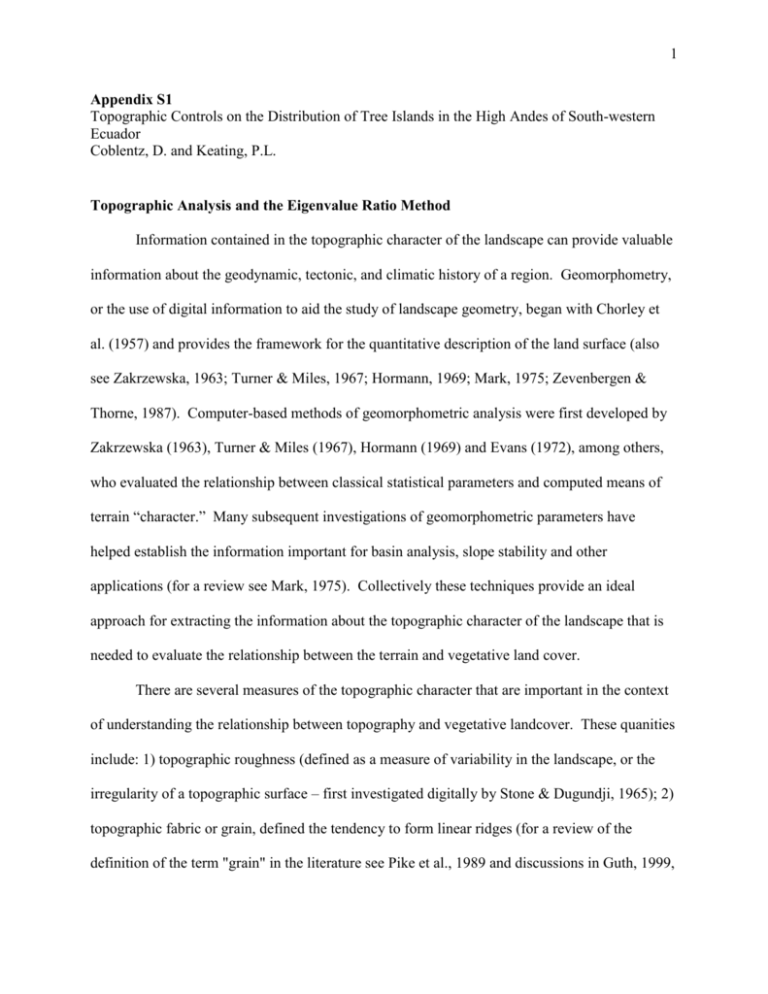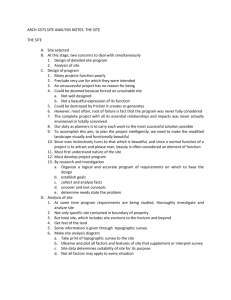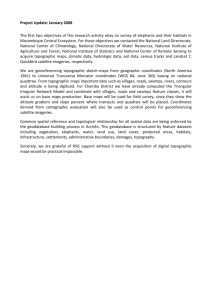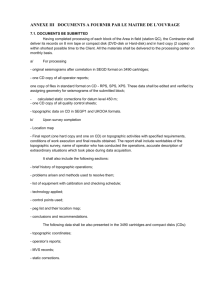Topographic factors influencing the spatial distribution of
advertisement

1 Appendix S1 Topographic Controls on the Distribution of Tree Islands in the High Andes of South-western Ecuador Coblentz, D. and Keating, P.L. Topographic Analysis and the Eigenvalue Ratio Method Information contained in the topographic character of the landscape can provide valuable information about the geodynamic, tectonic, and climatic history of a region. Geomorphometry, or the use of digital information to aid the study of landscape geometry, began with Chorley et al. (1957) and provides the framework for the quantitative description of the land surface (also see Zakrzewska, 1963; Turner & Miles, 1967; Hormann, 1969; Mark, 1975; Zevenbergen & Thorne, 1987). Computer-based methods of geomorphometric analysis were first developed by Zakrzewska (1963), Turner & Miles (1967), Hormann (1969) and Evans (1972), among others, who evaluated the relationship between classical statistical parameters and computed means of terrain “character.” Many subsequent investigations of geomorphometric parameters have helped establish the information important for basin analysis, slope stability and other applications (for a review see Mark, 1975). Collectively these techniques provide an ideal approach for extracting the information about the topographic character of the landscape that is needed to evaluate the relationship between the terrain and vegetative land cover. There are several measures of the topographic character that are important in the context of understanding the relationship between topography and vegetative landcover. These quanities include: 1) topographic roughness (defined as a measure of variability in the landscape, or the irregularity of a topographic surface – first investigated digitally by Stone & Dugundji, 1965); 2) topographic fabric or grain, defined the tendency to form linear ridges (for a review of the definition of the term "grain" in the literature see Pike et al., 1989 and discussions in Guth, 1999, 2 2003); 3) Topographic organization (where large values indicate a dominant linear fabric to the terrain, low values isotropic topography, see discussion in Guth (2003)), and 4) the topographic gradient. Quantification of the topographic fabric is accomplished using the Eigenvalue Ratio Method for evaluating the topographic roughness and organization (Watson, 1966; Woodcock, 1977). Certain ratios of the three principal eigenvalues, derived from the “orientation tensor” constructed from the collection of surface normal vectors, yield information about the topographic roughness and organization, and provide a useful method for analyzing the topographic fabric of a DEM. Chapman (1952) and Woodcock (1977) explored the use of the eigenvalue method for fabric shapes in structural geology, and more recently, the two methods have been combined for automatic characterization of terrain organization (Guth, 1999). An excellent review of the application of this technique for the evaluation of landslide surfaces can be found in McKean & Roering (2003). The surface normals (constructed by taking the unit vectors perpendicular to each cell in the DEM) are defined in polar coordinates by the direction cosines: xi=sini cosi, yi=sinisini, and zi=cos i, where i is the colatitude (90o - latitude) and i is the longitude of a unit orientation vector. The surface normals for rough topography show considerably more scatter compared to those of flat surfaces (Fig. S1). The normals to the Earth's surface can be viewed as a cloud of vectors in space, and the three eigenvectors associated with the vector cloud define a three dimensional ellipsoid that reflects their distribution (Woodcock, 1977). Local variability in the orientation data is evaluated statistically, and certain ratios of the eigenvalues provide quantitative information about the topographic character (roughness, organization and grain orientation). If (x1, y1, z1) ... (xn, yn, zn) represent a collection of n unit vectors perpendicular to 3 the n topographic surfaces described by a DEM, then the orientation matrix T (Equation 1) can be formed by the sums of the cross products of the direction cosines (Fara & Scheidegger, 1963; Scheidegger, 1965; Watson, 1966; Fisher et al., 1987). 2 y xi xi i xi z i 2 T y x i y y z i i i i 2 z i x i z i y i z i (1) Performing an eigenvalue analysis on the T matrix yields three eigenvalues and three eigenvectors. The relative magnitudes of the three eigenvectors, and their orientation, define the distribution. If the three eigenvalues (S1, S2, S3) are normalized with respect to n, then Si=i/n and S1+ S2+ S3=1. For most landscape surfaces the relationships between the three eigenvalues (and their associated eigenvectors) can be generalized as follows: 1) the eigenvalue S1 is much greater than S2; 2) S2 is approximately equal to S3; 3) the eigenvector associated with S1 is approximately vertical and those associated with S2 and S3 lie in the horizontal plane; and 4) the eigenvector S3 points in the direction of the dominant topographic fabric or the topographic grain. Various ratios of the eigenvalues yield useful geomorphometric parameters, including the topographic roughness [R1 = 1/(ln(S1/S2 ))], the topographic organization [R2 = ln(S2/S3)], strength [R3 = ln(S1/S3)], and a parameter K defined as the ratio of flatness to organization: [ln(S1/S2 ) / ln(S2/S3)]. Because there are only two independently varying eigenvalues, the flatness (the ratio ln(S1/S2 )) can be plotted against organization (ln(S2/S3)) to describe the pattern of vector orientations, which range from clusters to girdles (Woodcock, 1977). 4 Example distributions are shown in Fig. S2. The orientation data are considered clustered when S1> S2~ S3, and form a girdle distribution when S1~ S2> S3. The strength parameter increases with radial distance from the origin. Some examples of possible end members for topographic distributions include: 1) uniformly scattered surface vectors (perfectly rough topography) in which case S1= S2= S3=0.33 and the data would plot at the origin of the graph; 2) uniformly flat topography that produces uniform surface normal vectors, which would plot in the upper left corner (both extremely large K and strength values); and 3) perfectly random surface which would plot along the K=0 axis. References Chapman, C.A. (1952) A new quantitative method of topographic analysis. American Journal of Science, 250, 428-452. Chorley, R.J., Malm, D.E.C. & Pogorzelski, H.A. (1957) A new standard for measuring drainage basin shape. American Journal of Science, 255, 138-141. Evans, I.S. (1972) General geomorphology, derivatives of altitude and description of statistics. Spatial Analysis in Geomorphology (ed. by R.J. Chorley) pp. 17-90. Methuen & Co. Ltd., London. Fara, H.D. & Scheidegger, A.E. (1963) An eigenvalue method for the statistical evaluation of fault plane solutions of earthquakes. Seismological Society of America Bulletin, 53, 811-816. Fisher, N.I., Lewis, T. & Embleton, B.J. (1987) Statistical Analysis of Spherical Data. Cambridge University Press, New York. Guth, P.L. (1999) Quantifying and Visualizing Terrain Fabric from Digital Elevation Models. Geocomputation 99: Proceedings of the 4th International Conference on GeoComputation 5 (ed. by J. Diaz, R. Tynes, D. Caldwell, and J. Ehlen) http://www.geovista.psu.edu/geocomp/geocomp99/index.htm. Guth, P.L. (2003) Terrain Organization Calculated From Digital Elevation Models: in Evans, I.S., Dikau, R., Tokunaga, E., Ohmori, H., and Hirano, M., eds., Concepts and Modelling in Geomorphology: International Perspectives: Terrapub Publishers, Tokyo, p.199-220. Online at http://www.terrapub.co.jp/e-library/ohmori/pdf/199.pdf. Horman, K. (1969) Geomorphologische Kartenanalyse mit Hilfe elektronischer Rechenanlagen. Zeitschrift für Geomorphologie, 13, 75-98. Mark, D.M. (1975) Geomorphometric parameters: a review and evaluation. Geografiska Annaler, Series A, Physical Geography, 57, 165-177. McKean, J. & Roering, J. (2003) Objective landslide detection and surface morphology mapping using high-resolution airborne laser altimetry. Geomorphology, 57, 331-351. Pike, R.J., Acevedo, W. & Card, D.H. (1989) Topographic grain automated from digital elevation models. Proceedings, 9th International Symposium on Computer Assisted Cartography, Baltimore, April 2-7, 1989, ASPRS/ACSM, p.128-137. Scheidegger, A.E. (1965) On the statistics of the orientation of bedding planes, grain axes, and similar sedimentological data. US Geological Survey Professional Paper 525-C, C164-C167. Stone, R.O. & Dugundji, J. (1965) A study of microrelief – its mapping, classification and quantification by mean of a Fourier analysis. Engineering Geology, 1, 89-187. Turner, A.K. & Miles, C.R. (1965) Terrain analysis by computer. Proceedings of the Indiana Academy of Sciences, 77, 256-270. Watson, G.S. (1966) The statistics of orientation data. Journal of Geology, 74, 786-797. 6 Woodcock, N.H. (1977) Specification of fabric shapes using an eigenvalue method. Geological Society of America Bulletin, 88, 1231-1236. Zakrzewska, B. (1963) An analysis of landforms in a part of the central Great Plains. Annals of the Association of American Geographers, 53, 536-568. Zevenbergen, L.W. & Thorne, C.R. (1987) Quantitative analysis of land surface topography. Earth Surface Processes and Landforms, 12, 47-56. 7 Figure S1. Topographic surface roughness in a hypothetical DEM as defined by the unit surface normal vectors. For smooth topography (a), the vectors are coherent as indicated by the clustering in the steronet of the vector orientations. Conversely, for rough topography (b), the vectors have greater dispersion as reflected in the steronet mapping. After Hobson (1972). Figure S2. The location in K-space (a plot of topographic flatness, ln[S1/S2] plotted vs. the topographic organization, ln[S2/S3]) of several example distribution of surface normals (Woodcock, 1977). Tightly clustered distributions fall towards the flatness axis (large K values), while loosley clustered distributions fall below the K=1 line, which demarks the gridle-cluster transition. Distance from the origin is governed by the strength parameter which is defined by ln[S1/S3]. Thus coherent, flat topographic surfaces (which tend to be poorly organized) plot in the upper-left corner of the K-space while relatively incoherent topographically rough distributions will plot lower and to the right. At the furthest extreme a purely random distribution will plot in the lower-right corner of K-space. After Woodcock (1977).







